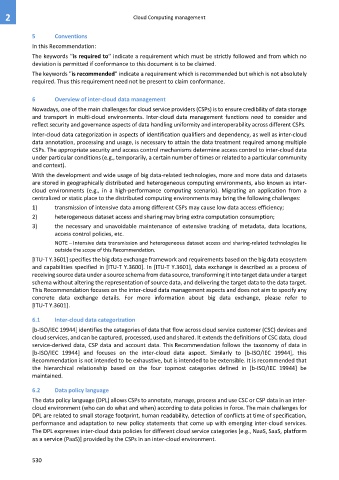Page 538 - Cloud computing: From paradigm to operation
P. 538
2 Cloud Computing management
5 Conventions
In this Recommendation:
The keywords ''is required to'' indicate a requirement which must be strictly followed and from which no
deviation is permitted if conformance to this document is to be claimed.
The keywords ''is recommended'' indicate a requirement which is recommended but which is not absolutely
required. Thus this requirement need not be present to claim conformance.
6 Overview of inter-cloud data management
Nowadays, one of the main challenges for cloud service providers (CSPs) is to ensure credibility of data storage
and transport in multi-cloud environments. Inter-cloud data management functions need to consider and
reflect security and governance aspects of data handling uniformity and interoperability across different CSPs.
Inter-cloud data categorization in aspects of identification qualifiers and dependency, as well as inter-cloud
data annotation, processing and usage, is necessary to attain the data treatment required among multiple
CSPs. The appropriate security and access control mechanisms determine access control to inter-cloud data
under particular conditions (e.g., temporarily, a certain number of times or related to a particular community
and context).
With the development and wide usage of big data-related technologies, more and more data and datasets
are stored in geographically distributed and heterogeneous computing environments, also known as inter-
cloud environments (e.g., in a high-performance computing scenario). Migrating an application from a
centralized or static place to the distributed computing environments may bring the following challenges:
1) transmission of intensive data among different CSPs may cause low data access efficiency;
2) heterogeneous dataset access and sharing may bring extra computation consumption;
3) the necessary and unavoidable maintenance of extensive tracking of metadata, data locations,
access control policies, etc.
NOTE – Intensive data transmission and heterogeneous dataset access and sharing-related technologies lie
outside the scope of this Recommendation.
[ITU-T Y.3601] specifies the big data exchange framework and requirements based on the big data ecosystem
and capabilities specified in [ITU-T Y.3600]. In [ITU-T Y.3601], data exchange is described as a process of
receiving source data under a source schema from data source, transforming it into target data under a target
schema without altering the representation of source data, and delivering the target data to the data target.
This Recommendation focuses on the inter-cloud data management aspects and does not aim to specify any
concrete data exchange details. For more information about big data exchange, please refer to
[ITU-T Y.3601].
6.1 Inter-cloud data categorization
[b-ISO/IEC 19944] identifies the categories of data that flow across cloud service customer (CSC) devices and
cloud services, and can be captured, processed, used and shared. It extends the definitions of CSC data, cloud
service-derived data, CSP data and account data. This Recommendation follows the taxonomy of data in
[b-ISO/IEC 19944] and focuses on the inter-cloud data aspect. Similarly to [b-ISO/IEC 19944], this
Recommendation is not intended to be exhaustive, but is intended to be extensible. It is recommended that
the hierarchical relationship based on the four topmost categories defined in [b-ISO/IEC 19944] be
maintained.
6.2 Data policy language
The data policy language (DPL) allows CSPs to annotate, manage, process and use CSC or CSP data in an inter-
cloud environment (who can do what and when) according to data policies in force. The main challenges for
DPL are related to small storage footprint, human readability, detection of conflicts at time of specification,
performance and adaptation to new policy statements that come up with emerging inter-cloud services.
The DPL expresses inter-cloud data policies for different cloud service categories [e.g., NaaS, SaaS, platform
as a service (PaaS)] provided by the CSPs in an inter-cloud environment.
530

